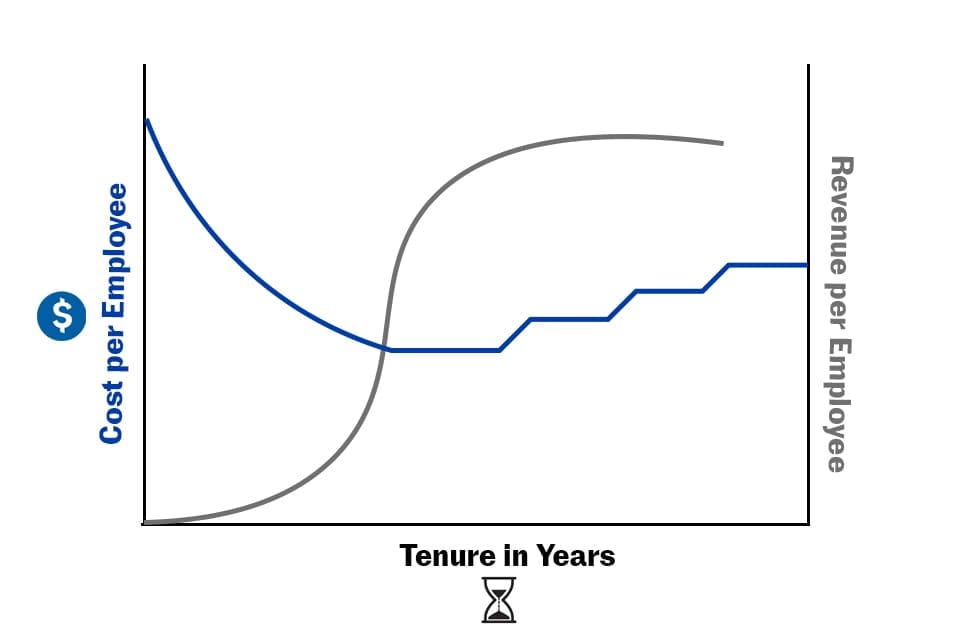Revenue per employee: The people metric making it into executive conversations
“Revenue per employee has the attention of senior leadership as one of a number of key metrics for SaaS startups. It provides a direct link to productivity— measuring how efficient the business is at bringing its product to market. Although it is a lagging indicator of success, its trend and next twelve-months forecast can help support decision making that fuels your growth appetite and hunger to double down on a plan.”
—Robert Bromage, CEO of IntelliHR
A 2007 McKinsey article pointed to the gap in financial reporting: “Companies focus far too much on measuring returns on invested capital rather than on measuring the contributions made by their talented people.” This doesn’t account for the true engines of growth for enterprise SaaS companies today: “the knowledge, relationships, reputations and other intangibles created by talented people and represented by investments in such activities as R&D, marketing and training.”
What is revenue per employee?
Revenue per employee is a productivity metric. It tells you how each additional hire or existing employee adds to your top line. New hires fuel growth, even if this growth lags a bit as they ramp up their productivity. As employees gain experience in the business, their contribution value incrementally increases (hopefully) or at least remains constant.
Why measure revenue per employee?
Looking at revenue per employee numbers, in combination with employee costs and tenure, provides visibility into the lifetime value of employees. In addition to the typical high-growth KPIs, a scaling business should understand how its employee productivity, costs and tenure numbers compare to other companies at a similar stage and to itself over time.


A scaling business should be able to answer these three questions at a moment’s notice.
- How much does it cost to find, train and keep an employee in our business?
- How much do employees contribute to our top line?
- How long do employees stay in our company?
Another interesting dimension of revenue per employee is its correlation with employee growth. There is almost a .975 correlation between revenue per employee and employee growth according to Bloom Street Ventures’ review of 77 publicly traded enterprise SaaS companies.
How to calculate revenue per employee
Revenue per employee can be calculated in three ways, but option three is the most indicative of future growth.
Option 1: Total annual revenue / total employees as at December 31
Option 2: Total December revenue x 12 / total employees as at December 31
Option 3: Total December quarter revenue x 4 / total average employees December quarter
What’s a good revenue per employee score?
The ideal revenue per employee for enterprise SaaS companies is $120,000 per employee for companies under $20 million in revenue to $168,000 per employee for companies up to $100 million in revenue, according to a 2018 OpexEngine study. If you consider that the average tech salary is $100,000, twice the return is a good aspirational target as companies scale operationally.
In addition to external benchmarks, it is best practice for companies to compare their own numbers over a few years to see if their ratios are declining or improving. Using these numbers as learning moments can create value for the business.
So you want to improve your revenue per employee—what next?
As a scaling company, you rely on your key people assets to fuel your top-line growth. There are many opportunities during the employee lifecycle to maximize revenue per employee. Here are few questions to help you identify them.
- Is every additional hire justified in terms of contribution to the top and bottom lines?
- Are you searching and paying for the best quality hire that will make a contribution faster?
- Are your high-performing or potential talent reaching their maximum output? This could be accelerated through mentoring or growth opportunities, for example.
- Do you have the people, processes and tools in place to enable contribution at every stage of the employee lifecycle? For example, do you have sufficient training and one-on-one coaching to ramp up new employees’ productivity as quickly as possible and get beyond their break-even point?
- Are you exiting underperforming talent at an early stage of their employment, even if they’re tenured? It’s important to catch any downward trend early, as it hurts the top and bottom lines, and creates an underperforming culture.


